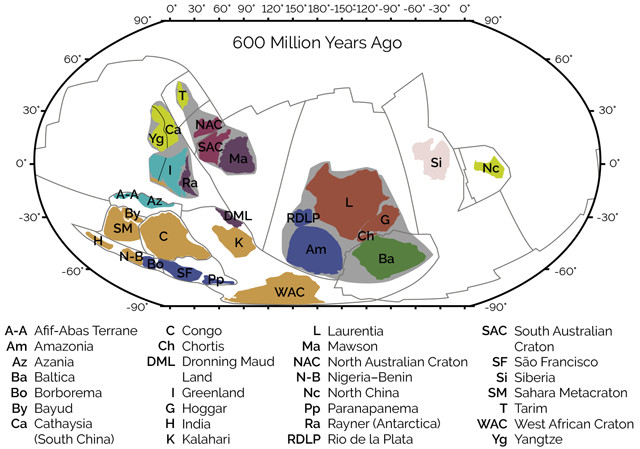
by Mary Caperton Morton Tuesday, July 3, 2018

Researchers have found evidence that a supercontinent, Pannotia, existed between 650 million and 600 million years ago, forming after Rodinia and before Pangea. Credit: Nance and Murphy, Geological Society Special Publications, March 2018.
Earth’s landmasses have joined together into supercontinents and then split apart again as many as six times in the planet’s history. Pangea is the most famous supercontinent, but at least five pre-Pangean supercontinents — Rodinia, Columbia, Kenorland, Ur and Vaalbara — have been widely championed, mainly based on paleomagnetic data. Now, a new study offers a panoply of evidence for an often-overlooked supercontinent thought to have formed after Rodinia and before Pangea, called Pannotia, whose existence has long been in question.
In 1982, when geologists Damian Nance and Tom Worsley of Ohio University first proposed the concept of a global supercontinent cycle — in which continents come together and break up repeatedly over hundreds of millions of years, “people thought we were nuts,” Nance says. At the time, Pangea was widely thought to have been the only supercontinent in Earth’s history, but Nance and Worsley offered a litany of evidence that all the continents had joined together and broken apart numerous times before Pangea in a self-sustaining cycle. In the new study, published by the Geological Society of London, Nance and co-author Brendan Murphy of St. Francis Xavier University in Nova Scotia, Canada, present evidence of the short-lived Pannotia, which might have formed about 600 million years ago.
Evidence for other supercontinents comes largely from paleomagnetic data. But such data has been inconclusive for rocks dating from 650 million to 550 million years ago.
As Earth’s magnetic field changes orientation over geologic time, magnetic signatures recorded in magnetized grains in some rocks allow geoscientists to retrace the movements of continents. The technique can determine the positions of landmasses with respect to latitude, but not longitude, so you can determine that a landmass was positioned on the equator, but not where on the equator. “This precise slice of time is one of the most difficult periods for interpreting paleomagnetic data,” says Joseph Meert, a geologist at the University of Florida in Gainesville, who was not involved in the study. “We have data from the same rock that appear to give signals of both high and low latitudes at the same time,” Meert says. “It’s really bizarre.”
Nance’s latest effort to make a case for Pannotia sidesteps the paleomagnetic problem by offering other lines of evidence that the planet’s continents came together in the Southern Hemisphere for at least 50 million years between the times when Rodinia and Pangea existed. “When you assemble a supercontinent and then break it up, you produce all sorts of amazing changes in Earth’s surface systems,” Nance says. The most obvious signs are global episodes of mountain building when continents collide, and large-scale rifting when they separate. Other changes run the gamut from fluctuating ocean chemistry to dramatic climatic changes, including ice ages, to widespread radiations and extinctions in the biosphere as habitats are created and destroyed.
“If we look at changes in sea level, climate and the biosphere during this period between 650 million and 550 million years ago, it’s very similar to what we see when Pangea was forming and splitting up,” Nance says. “It looks like all hell was breaking loose on Earth, and my guess is that Pannotia is at the center of all these weird and wonderful things that were happening at that time.”
Nance and Murphy also make a case for defining supercontinents not by size or the percentage of Earth’s total landmass included — Meert has suggested that supercontinents should contain at least 75 percent of available landmasses — but by the processes involved: “In my view, a supercontinent only needs to be large enough to initiate the mantle circulation processes that cause the landmass to break up. It only needs to be big enough to trigger its own self-destruction and ensure the cycle repeats,” Nance says.
The combined evidence is intriguing but not yet a slam dunk, Meert says. “I don’t think that the issue of Pannotia’s existence is solved by this new study, but it gives a nice earth systems perspective for where one might look for evidence for supercontinents when you can’t rely on paleomagnetic data.”
One way to resolve the debate, absent paleomagnetic evidence, is to refine the dates for the events that Nance and Murphy cite as evidence for Pannotia, Meert says. Many of the dates cited overlap, allowing only a 50-million-year window for Pannotia to exist intact before breaking up. “If Pannotia is a supercontinent, it was very ephemeral, lasting the shortest amount of time of all the supercontinents,” Meert says. “To me, the timing of when all this was happening is still a very big issue.”
© 2008-2021. All rights reserved. Any copying, redistribution or retransmission of any of the contents of this service without the expressed written permission of the American Geosciences Institute is expressly prohibited. Click here for all copyright requests.